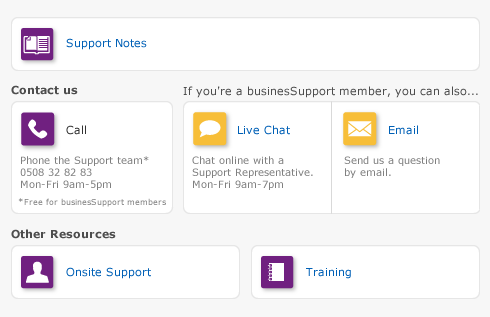Reports > Producing reports
You can print, email or fax reports, output them to various file formats or export them to other software for further modifications.
|
1
|
|
2
|
Locate the report you want to display or print. Select it and click Display. The Report Display window appears.
|
|
a
|
|
b
|
To reposition a column, position the cursor over the column header until the cursor changes to the hand icon (
|
|
c
|
To change the width of a column, position the cursor over the icon of a column border (
|
|
4
|
If you want to limit the data that will be printed in the report, click Customise and specify the data you want. For more information, see Customising reports.
|
|
5
|
|
a
|
Click Save As. Type a name for the report.
|
|
b
|
|
7
|
Click Print.
|
You can save reports in various file formats so that they can be viewed and edited in other software.
|
1
|
|
3
|
If you want to limit the data that will appear in the report, click Customise and specify the data you want. For more information, see Customising reports.
|
|
4
|
Click Send To and choose one of the following file formats:
|
|
▪
|
PDF (Portable Document Format) If you save a report as a PDF file, the person who receives the report must have software, such as Adobe Reader, for viewing the PDF file.
|
|
▪
|
HTML When you save a report in HTML (Hypertext Markup Language) format, the report can be viewed in web browsers such as Microsoft Internet Explorer.
|
|
▪
|
Tab-Delimited Text File When you save a report as a tab-delimited text file, fields in the report are separated by tab spaces. Tab-delimited text files can be opened by most word processing and spreadsheet software.
|
|
▪
|
Comma-Separated Text When you save a report in comma-separated text file format, fields in the report are separated by commas. Comma-separated text files can be opened by most word processing and spreadsheet software.
|
|
▪
|
Simple Text File When you save a report in simple text file format, fields are separated by spaces so the appearance of the report is as similar as possible to a printed version of the report. Simple text files can be opened by most word processing and spreadsheet software.
|
|
5
|
When you send a report by email, the report is saved as a PDF file and attached to the body of the email message. Your recipient needs a PDF file viewer, such as Adobe Reader, to view the report.
|
1
|
|
3
|
To limit the data that will appear in the report, click Customise and specify the data you want. For more information, see Customising reports.
|
|
4
|
|
5
|
In the Name field, type or select the individual or organisation you want to send the report to.
|
|
8
|
Click Send. The email is sent to your email software’s outbox with the report attached as a PDF file.
|
|
9
|
Send the email and attachment from your email software as you normally would.
|
If you have fax software installed on your computer, you can send your reports by fax. Windows XP includes fax software. For more information, see Windows Help.
|
1
|
|
3
|
To limit the data that will appear in the report, click Customise and specify the data you want. For more information, see Customising reports.
|
|
4
|
In Excel, you can open reports that you have saved as tab-delimited text files, comma-separated text files or simple text files.
|
1
|
|
3
|
To limit the data that will appear in the report, click Customise and specify the data you want. For more information, see Customising reports.
|
|
4
|
Each report in your software has a corresponding Excel template. All Excel templates are stored in a folder named Spredsht, which is located in your AccountRight software folder. You can modify these templates if you want.
For a list of the Excel templates and the reports they correspond to, see Microsoft Excel templates.
If you modify the Excel templates, do not move the [[Tbl:Body Table]] field. This field must be located in Column B, row 15, in order for each report’s total amounts to be calculated correctly. If you move [[Tbl:Body Table]], the totals will be inaccurate.
Also note that if you want to perform additional calculations using the exported report data, you should either create a macro that will perform the calculation after the report is imported, or place your reference fields on a separate spreadsheet and update it after the report is imported. Please refer to your Excel documentation for specific help.

